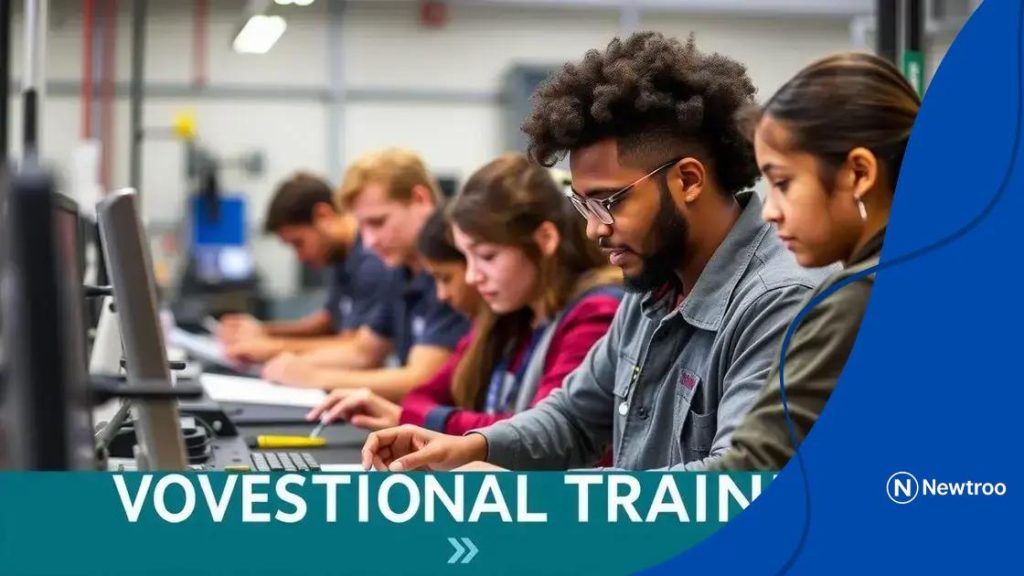Trump redirects $3B from Harvard funding to vocational education

Anúncios
Trump redirects $3B from Harvard funding to prioritize vocational education, enhancing resources for practical skills training and addressing workforce demands.
Trump redirects $3B from Harvard funding to vocational education, prompting significant discussions on resource allocation in education. What does this mean for the future of vocational programs?
Anúncios
Understanding the funding shift
The recent decision by Trump to redirect $3B from Harvard funding marks a significant shift in how educational funding is perceived and distributed. This shift is crucial as it aims to bolster vocational education, which has often been overshadowed by traditional higher education institutions.
By understanding the funding shift, we can explore its implications and the potential benefits it may bring to vocational programs across the country. Vocational education plays a vital role in preparing students for the workforce, ensuring they have the skills needed to succeed in various trades and industries.
Key Aspects of the Funding Shift
Several important aspects can be highlighted regarding this funding shift:
Anúncios
- Allocation of Funds: The redirection of funds means that more resources will be available for vocational training programs.
- Industry Demand: As industries evolve, the need for skilled workers continues to grow, making vocational education increasingly relevant.
- Partnership Opportunities: Schools can create partnerships with local businesses to enhance training programs.
- Student Accessibility: With increased funding, opportunities for a diverse range of students to access vocational training may improve.
As we examine this funding shift further, it is essential to consider how it will alter the landscape of higher education. Traditional programs may need to adapt to maintain their relevance in an ever-changing job market.
In addition, the focus on vocational education provides a viable alternative for students who seek immediate employment after graduation, rather than pursuing extensive university programs. This shift could lead to a more skilled workforce, benefiting both students and employers alike.
Impact on vocational education programs
The impact on vocational education programs due to the funding redirection is significant and multifaceted. As resources shift, these programs have the potential to expand and adapt to the evolving needs of our economy.
With increased funding from the $3B redirected from Harvard, vocational programs can enhance their facilities, improve training equipment, and update curricula. This means students can gain access to better training that reflects real-world job requirements.
Benefits of Increased Funding
There are several key benefits associated with this funding shift:
- Resource Enhancement: Upgrading tools and classrooms can create a better learning environment for students.
- Curriculum Development: Programs can incorporate the latest technologies and practices, keeping lessons relevant.
- Stronger Industry Ties: More funding can foster partnerships with local businesses, ensuring programs meet job market requirements.
- Increased Enrollment: With improved programs, more students may be encouraged to pursue vocational education.
The ability to hire qualified instructors also becomes more feasible with increased financial support. Skilled educators can provide invaluable insights and training, which is essential for students preparing to enter competitive job markets. Moreover, vocational education plays a crucial role in addressing the skills gap faced by many industries.
Investing in vocational programs not only benefits students but also supports local economies. As more individuals gain practical skills, they contribute effectively to various sectors. A stronger skilled workforce can attract new businesses and industries, further enhancing economic growth.
Reactions from Harvard and educational leaders

The reactions from Harvard and educational leaders regarding the redirection of funds are varied and complex. Many are voicing concerns about the implications of taking money away from prestigious institutions.
Harvard officials expression strong sentiments about the decision. They argue that cutting funding can limit their capacity to support research and education. With less financial backing, programs that contribute significantly to academic progress may struggle to maintain high standards.
Concerns Raised by Educational Leaders
Several key concerns have emerged from this situation:
- Impact on Research: Research initiatives at Harvard may face cutbacks, hindering innovation and discovery.
- Student Programs: Financial support for scholarships and essential programs could diminish, impacting students’ experiences.
- Reputation Risks: A decline in funding could potentially affect Harvard’s status as a leading institution.
- Broader Implications: Other universities may feel pressure to reconsider their funding structures and priorities.
In addition to these concerns, many educational leaders stress the need for balanced approaches to funding. They emphasize the importance of ensuring that all levels of education, including vocational programs, receive necessary support. It is crucial to prepare students with a well-rounded education that meets market demands.
Additionally, reactions highlight the necessity for dialogue among stakeholders. Communication between universities and policymakers can help create solutions that benefit all educational sectors. As discussions continue, the hope remains that collaborative efforts will lead to better funding practices.
Future implications for higher education policy
The future implications for higher education policy are significant as the funding landscape continues to evolve. The decision to redirect funds has sparked discussions about how educational resources are allocated across institutions.
As the focus shifts towards vocational education, policymakers may have to reconsider their funding strategies. This change can provide opportunities for innovation and improvements in various educational sectors.
Key Areas of Impact
Several key areas are likely to be influenced by this funding shift:
- Equitable Funding Models: Policymakers may explore fair distributions of funding that support both traditional universities and vocational programs.
- Skills Development: A greater emphasis on vocational education may lead to a curriculum that aligns more closely with labor market needs, ensuring graduates are job-ready.
- Collaboration Between Institutions: Increased dialogue between universities and vocational schools can foster partnerships, share resources, and create dual-enrollment options for students.
- Policy Reform: The need for reforms that adapt to new educational demands may arise, influencing how funding and resources are structured.
In addition to these areas, the ongoing conversation about educational equity will likely gain momentum. Ensuring all students have access to quality training and education is critical for a thriving economy. As vocational education gains attention, it is essential to advocate for balanced support across all educational paths.
Moreover, these changes might encourage new forms of assessment and accountability within educational programs. Understanding the effectiveness of vocational training can lead to improved policies and standards that benefit students and employers alike.
Exploring alternatives for education funding
Exploring alternatives for education funding is essential in light of recent shifts in resources. As funding landscapes change, stakeholders are looking for new methods to ensure that all educational institutions receive adequate support.
One approach involves diversifying funding sources. Schools can seek partnerships with local businesses and industry leaders, which can provide financial support and resources for training programs. This not only helps to fund educational initiatives but also creates pathways for students to secure jobs upon graduation.
Potential Alternative Funding Sources
Several alternative funding sources can be considered:
- Public-Private Partnerships: Collaborations between government entities and private organizations can help pool resources for educational programs.
- Grants and Scholarships: Seeking grants from non-profits or government agencies can provide essential funding. Scholarships can also incentivize students to enroll in critical fields.
- Crowdfunding Campaigns: Utilizing crowdfunding platforms allows communities to contribute directly to local educational projects.
- Alumni Contributions: Encouraging alumni to donate can strengthen funding for schools and programs they once attended.
In addition to these traditional methods, technology can enhance fundraising efforts. Online platforms can be utilized to reach a wider audience, making it easier to gather support for educational causes. As schools explore innovative funding solutions, they can better meet the needs of students and adapt to the demands of the job market.
Overall, the exploration of alternative funding for education will require creativity and collaboration among various stakeholders. By proactively seeking new resources, schools can build a robust educational framework that benefits all learners.
FAQ – Frequently Asked Questions about Education Funding Shifts
What is the main reason for the funding shift from Harvard?
The funding shift aims to prioritize vocational education, ensuring resources are allocated to programs that prepare students for the workforce.
How does this change impact vocational education programs?
Increased funding for vocational programs allows for better training facilities, updated equipment, and enhanced curriculum tailored to industry needs.
What alternative funding sources can schools explore?
Schools can explore public-private partnerships, grants, crowdfunding, and alumni donations as alternative funding sources to support their programs.
Why is collaboration between educational institutions and businesses important?
Collaboration ensures that training programs align with market demands, providing students with the necessary skills for employment and benefiting local economies.